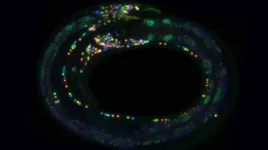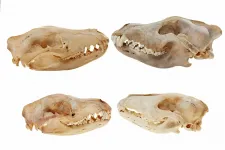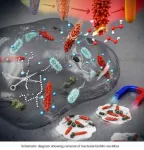Single-dose COVID-19 vaccine triggers antibody response in mice
2021-01-08
(Press-News.org) Across the world, health care workers and high-risk groups are beginning to receive COVID-19 vaccines, offering hope for a return to normalcy amidst the pandemic. However, the vaccines authorized for emergency use in the U.S. require two doses to be effective, which can create problems with logistics and compliance. Now, researchers reporting in ACS Central Science have developed a nanoparticle vaccine that elicits a virus-neutralizing antibody response in mice after only a single dose.
The primary target for COVID-19 vaccines is the spike protein, which is necessary for SARS-CoV-2's entry into cells. Both of the vaccines currently authorized in the U.S. are mRNA vaccines that cause human cells to temporarily produce the spike protein, triggering an immune response and antibody production. Peter Kim and colleagues wanted to try a different approach: a vaccine consisting of multiple copies of the spike protein displayed on ferritin nanoparticles. Ferritin is an iron storage protein found in many organisms that self-assembles into a larger nanoparticle. Other proteins, such as viral antigens, can be fused to ferritin so that each nanoparticle displays several copies of the protein, which might cause a stronger immune response than a single copy.
The researchers spliced spike protein and ferritin DNA together and then expressed the hybrid protein in cultured mammalian cells. The ferritin self-assembled into nanoparticles, each bearing eight copies of the spike protein trimer. The team purified the spike/ferritin particles and injected them into mice. After a single immunization, mice produced neutralizing antibody titers that were at least two times higher than those in convalescent plasma from COVID-19 patients, and significantly higher than those in mice immunized with the spike protein alone. A second immunization 21 days later produced even higher antibody levels. Although these results must be confirmed in human clinical trials, they suggest that the spike/ferritin nanoparticles may be a viable strategy for single-dose vaccination against COVID-19, the researchers say.
INFORMATION:
The authors acknowledge funding from the Stanford Maternal & Child Health Research Institute, the Damon Runyon Cancer Research Foundation, the National Institutes of Health, the Chan Zuckerberg Biohub, the Virginia and D. K. Ludwig Fund for Cancer Research and the Frank Quattrone and Denise Foderaro Family Research Fund.
The paper is freely available as an ACS AuthorChoice article here.
The American Chemical Society (ACS) is a nonprofit organization chartered by the U.S. Congress. ACS' mission is to advance the broader chemistry enterprise and its practitioners for the benefit of Earth and its people. The Society is a global leader in providing access to chemistry-related information and research through its multiple research solutions, peer-reviewed journals, scientific conferences, eBooks and weekly news periodical Chemical & Engineering News. ACS journals are among the most cited, most trusted and most read within the scientific literature; however, ACS itself does not conduct chemical research. As a specialist in scientific information solutions (including SciFinder® and STN®), its CAS division powers global research, discovery and innovation. ACS' main offices are in Washington, D.C., and Columbus, Ohio.
To automatically receive news releases from the American Chemical Society, contact newsroom@acs.org.
Follow us: Twitter | Facebook
ELSE PRESS RELEASES FROM THIS DATE:
2021-01-08
In 2020, astronomers added a new member to an exclusive family of exotic objects with the discovery of a magnetar. New observations from NASA's Chandra X-ray Observatory help support the idea that it is also a pulsar, meaning it emits regular pulses of light.
Magnetars are a type of neutron star, an incredibly dense object mainly made up of tightly packed neutron, which forms from the collapsed core of a massive star during a supernova.
What sets magnetars apart from other neutron stars is that they also have the most powerful known magnetic fields in the universe. For context, the strength of our planet's magnetic field has a value of about one Gauss, while a refrigerator magnet measures about ...
2021-01-08
UC San Francisco scientists have discovered a new way to control the immune system's "natural killer" (NK) cells, a finding with implications for novel cell therapies and tissue implants that can evade immune rejection. The findings could also be used to enhance the ability of cancer immunotherapies to detect and destroy lurking tumors.
The study, published January 8, 2021 in the Journal of Experimental Medicine, addresses a major challenge for the field of regenerative medicine, said lead author Tobias Deuse, MD, the Julien I.E. Hoffman, MD, Endowed Chair in Cardiac Surgery in the UCSF Department of Surgery.
"As a cardiac surgeon, I would love to put myself out of business by being able to implant healthy cardiac ...
2021-01-08
The SARS-CoV-2 virus was introduced to the United Kingdom well over 1,000 times in early 2020, according to researchers who analyzed more than 50,000 viral sequences from the first wave of the COVID-19 pandemic in the UK. The virus lineages introduced before the UK's national lockdown in March tended to be larger and more geographically dispersed. Infectious disease epidemics are composed of chains of transmission, yet little is known about how co-circulating transmission lineages vary in size, spatial distribution and persistence. Understanding these features could help target interventions, track variants with different impacts on their human hosts, and more. The UK's COVID-19 epidemic during early 2020 was one of the world's largest. It was also well represented by virus genomic sampling, ...
2021-01-08
The human brain contains approximately 86 billion neurons, or nerve cells, woven together by an estimated 100 trillion connections, or synapses. Each cell has a role that helps us to move muscles, process our environment, form memories, and much more.
Given the huge number of neurons and connections, there is still much we don't know about how neurons work together to give rise to thought or behavior.
Now Columbia scientists have engineered a coloring technique, known as NeuroPAL (a Neuronal Polychromatic Atlas of Landmarks), which makes it possible--at least in experiments with Caenorhabditis elegans (C. elegans), a worm species commonly used in biological ...
2021-01-08
Micro-CT scanning and digital reconstructions have been used to compare the skulls of the Tasmanian tiger (thylacine) and wolf across their early development and into adulthood, establishing that not only did the thylacine resemble the wolf as adults, but also as newborns and juveniles.
"Remarkably, the Tasmanian tiger pups were more similar to wolf pups than to other closely related marsupials," Professor Andrew Pask from the University of Melbourne said.
The collaborative study with Flinders University and Museums Victoria complement earlier findings that thylacine and wolf have evolved similar instructions in their genome, which influence cranial stem cells during development.
While ...
2021-01-08
The COVID-19 pandemic is raising fears of new pathogens such as new viruses or drug-resistant bacteria. To this, a Korean research team has recently drawn attention for developing the technology for removing antibiotic-resistant bacteria by controlling the surface texture of nanomaterials.
A joint research team from POSTECH and UNIST has introduced mixed-FeCo-oxide-based surface-textured nanostructures (MTex) as highly efficient magneto-catalytic platform in the international journal Nano Letters. The team consisted of professors In Su Lee and ...
2021-01-08
COLUMBUS, Ohio - Scientists have figured out a cheaper, more efficient way to conduct a chemical reaction at the heart of many biological processes, which may lead to better ways to create biofuels from plants.
Scientists around the world have been trying for years to create biofuels and other bioproducts more cheaply; this study, published today in the journal Scientific Reports, suggests that it is possible to do so.
"The process of converting sugar to alcohol has to be very efficient if you want to have the end product be competitive with fossil fuels," said Venkat Gopalan, a senior author on the paper and professor of chemistry and biochemistry at The Ohio State University. ...
2021-01-08
The mitochondrial ATP synthase is energy-converting macromolecular machine that uses the electrochemical potential across the bioenergetic membrane called cristae. This potential is maintained via a membrane curvature that is induced by ATP synthase assembled in dimers. The dimers shaping the bioenergetic membrane were thought to be universal across the eukaryotic organisms. Two newly published cryo-EM studies by Kock-Flygaard et al and Mühleip et al from Alexey Amunts lab, identify different types of ATP synthase organization.
The structure of the ATP synthase from ciliates revealed a dimer, which unlike in all the previously investigated complexes, the two ...
2021-01-08
New Curtin University research has found a dramatic increase in people's trust in government in Australia and New Zealand as a result of the COVID pandemic.
Published in the Australian Journal of Public Administration, the team surveyed people in Australia and New Zealand in July 2020 and found confidence in public health scientists to also be high and for this trust to be manifested in higher usage of government COVID phone apps.
Lead researcher Professor Shaun Goldfinch, ANZSOG WA Government Chair in Public Administration and Policy based at the John Curtin Institute of Public Policy at Curtin said the management of the pandemic by authorities led to a dramatic increase in trust in government.
"Using an online panel, we surveyed a representative sample of 500 people each in Australia ...
2021-01-08
An important and still unanswered question is how new genes that cause antibiotic resistance arise. In a new study, Swedish and American researchers have shown how new genes that produce resistance can arise from completely random DNA sequences. The results have been published in the journal PLOS Genetics.
Antibiotic resistance is a major global problem and the spread of resistant bacteria causes disease and death, and constitutes a major cost to society. The most common way for bacteria to develop resistance is by taking up various types of resistance genes from other bacteria. These genes encode proteins (peptides) that can lead to resistance by: (i) deactivating the antibiotic, (ii) reducing its concentration, or (iii) altering ...
LAST 30 PRESS RELEASES:
[Press-News.org] Single-dose COVID-19 vaccine triggers antibody response in mice



